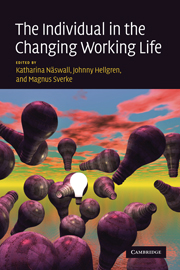Book contents
- Frontmatter
- Contents
- List of figures
- List of tables
- List of cases
- List of contributors
- Acknowledgements
- 1 The individual in the changing working life: introduction
- Part I Threats and challenges
- 2 New rules of work: exploring the boundaryless job
- 3 Changing work roles: new demands and challenges
- 4 The Demand-Induced Strain Compensation model: renewed theoretical considerations and empirical evidence
- 5 Job insecurity and employability among temporary workers: a theoretical approach based on the psychological contract
- 6 Independent contracting: finding a balance between flexibility and individual well-being
- 7 Work–family conflict in individuals' lives: prevalence, antecedents, and outcomes
- 8 My love, my life, my everything: work–home interaction among self-employed
- 9 Modern work and safety
- 10 Romantic relationships at work: old issues, new challenges
- 11 Ethnic diversity at work: an overview of theories and research
- Part II Individual attempts at restoring the balance
- Part III Intervention and promotion on the organizational level
- Index
- References
8 - My love, my life, my everything: work–home interaction among self-employed
Published online by Cambridge University Press: 13 October 2009
- Frontmatter
- Contents
- List of figures
- List of tables
- List of cases
- List of contributors
- Acknowledgements
- 1 The individual in the changing working life: introduction
- Part I Threats and challenges
- 2 New rules of work: exploring the boundaryless job
- 3 Changing work roles: new demands and challenges
- 4 The Demand-Induced Strain Compensation model: renewed theoretical considerations and empirical evidence
- 5 Job insecurity and employability among temporary workers: a theoretical approach based on the psychological contract
- 6 Independent contracting: finding a balance between flexibility and individual well-being
- 7 Work–family conflict in individuals' lives: prevalence, antecedents, and outcomes
- 8 My love, my life, my everything: work–home interaction among self-employed
- 9 Modern work and safety
- 10 Romantic relationships at work: old issues, new challenges
- 11 Ethnic diversity at work: an overview of theories and research
- Part II Individual attempts at restoring the balance
- Part III Intervention and promotion on the organizational level
- Index
- References
Summary
As a result of the increased number of dual-earner families and the widespread availability of information and communication technology, the boundaries between work and non-work have become blurred. Today, work is no longer necessarily spatially, temporally, and socially distinct from home. As a consequence, the amount of research into the work–home interface has increased. For example, statistics from the United States indicate that over 45% of employed parents feel that work interferes with their family life (negative work–home interaction; Bond, Thompson, Galinsky, and Prottas, 2003). Even higher percentages (58%) have been reported for the Canadian workforce (Duxbury and Higgins, 2001).
Work may also have positive consequences for functioning at home (Carlson, Kacmar, Wayne, and Grzywacz, 2006; Geurts et al., 2005; Greenhaus and Powell, 2006), for example because skills, positive moods, and acquired knowledge spill over to private life, helping workers to “become a better family member” (positive work–home interaction, Carlson et al., 2006). Similarly, the home situation may also interfere with or enhance functioning at work, for instance because one worries about one's children being ill (negative home–work interaction) or because positive moods spill over to the work situation (positive home–work interaction). Thus, work–home interaction may be defined as a process in which a worker's functioning in one domain is influenced by (negative or positive) load reactions that have built up in the other domain (Geurts, Kompier, Roxburgh, and Houtman, 2003).
- Type
- Chapter
- Information
- The Individual in the Changing Working Life , pp. 147 - 168Publisher: Cambridge University PressPrint publication year: 2008
References
- 4
- Cited by

